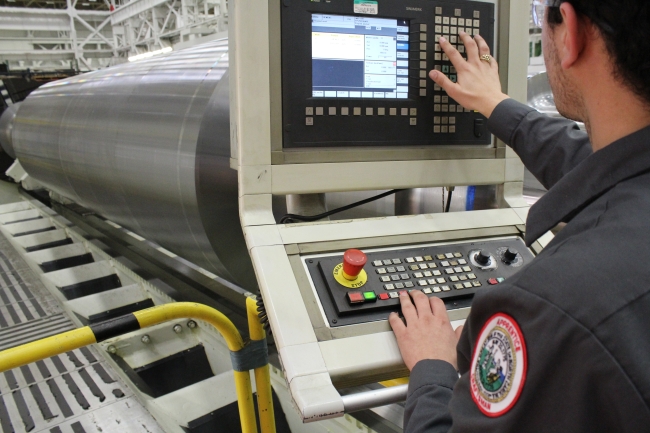You have /5 articles left.
Sign up for a free account or log in.

Courtesy of Siemens
David Whalen was a junior in high school when he learned about an apprenticeship program at the Siemens factory in Charlotte, N.C., which manufactures generators and turbines. Through the program he could get paid to work while earning an associate of science in mechatronics engineering technology -- a program that combines elements of electrical and mechanical engineering -- from Central Piedmont Community College. Siemens would pay his educational expenses.
“I was planning on going to school for engineering, but I knew how expensive it was,” said Whalen, who started at Siemens as a senior in high school and is now 21 years old. He graduated from Central Piedmont in May and will finish the four-year apprenticeship this summer, after which he plans to stay on at Siemens.
“It does have its ups and downs,” Whalen said of the apprenticeship experience. “You don’t have that university experience, living on campus and whatnot, but the perks definitely outweigh the social loss that you have not going to university. The degree is a good degree, and the money is definitely very nice for someone my age. Plus, this is hopefully going to lead to a very long career with the company.”
“I know for a fact that I can get through this apprenticeship program and still have a job and keep working as long as I want,” Whalen said.
As the U.S. has pushed to grow apprenticeship programs in recent years, German companies like Siemens have been at the forefront. Germany is known for its dual vocational education and training system, in which apprentices train in a specific company while enrolling in a public vocational school. Many credit Germany’s apprenticeship program for being a key factor in the country’s relatively low youth unemployment rate.
Judy Marks, the CEO of Siemens USA, said that when Siemens decided to relocate a facility to Charlotte in 2010, the company couldn’t find the skilled workers it needed. “So we turned to our colleagues in Germany, which has a very proven apprenticeship model, and tried to figure out how best to apply it in a country as diverse as the United States,” Marks said. Siemens now has apprenticeship programs, all in partnership with community colleges, at its locations in Alabama, California and Georgia, in addition to North Carolina, and plans to start programs in Louisiana, Pennsylvania, South Carolina and Texas.
"The apprentice model has made a difference for us,” Marks said. “Advanced manufacturing is not the manufacturing of the past. It’s highly computer driven and requires analytic skills, both of which need more than a high school education.”
“For a company to come here and say, ‘I need a CNC operator’ and put an ad in the paper, that’s no longer working,” said Richard Zollinger, the vice president for learning and work force development at Central Piedmont, using a common abbreviation to describe an operator of automated machinery. “They have to dig deeper into the pipeline and they have to partner with educational institutions like CPCC.”
Growing Interest in Apprenticeships
Apprenticeships are often discussed as a way to bridge the “skills gap,” in particular the gap in so-called middle skills, those that require more than a high school education and less than a four-year degree. Most apprenticeships in the U.S. have traditionally been in the building and construction trades, but there is increasing interest in expanding them into other fields like advanced manufacturing, information technology and health care. Models vary, but generally speaking they include a company training component and a formal educational program offered in partnership with a community college, four-year university, technical school or unaccredited educational provider (labor unions, for example, sometimes provide the educational component in line with industry standards). In these “earn-while-you-learn” programs, students work part-time and study part-time and earn a wage while they do it. In many cases, companies pay the cost of tuition and the apprentice's other educational expenses.
Broadly speaking, apprenticeships enjoy bipartisan support. The Obama administration directed roughly $250 million to expanding apprenticeships. In June, President Trump signed an executive order seeking to expand apprenticeships “while easing the regulatory burden on such programs” and carving out a larger role for industry groups and unions in certifying their quality.
Advocates for apprenticeship programs welcomed Trump’s focus on the subject but expressed concerns about the possible easing of wage and quality control standards that are in place for registered apprenticeship programs, which are administered by the Department of Labor and various state apprenticeship agencies. They also pointed out that the president’s push for apprenticeships -- and up to $200 million in possible funding for this purpose -- came at the same time he had proposed cuts to other work force and technical education programs in his budget.
A German and Swiss Educational Export
As interest in the apprenticeship model has grown, both the German and the Swiss governments -- Switzerland has a similar model -- have gotten involved in actively exporting the concept. Advocates for expanding apprenticeships stress that the models can’t be imported wholesale and that the contexts for work and school differ vastly across the countries. But they say the U.S. can borrow some general concepts, such as direct employer involvement -- and investment -- in education and training.
The German Embassy in Washington has been promoting apprenticeship programs through the government's skills initiative. “One of the biggest challenges -- and one which we are also facing in Germany -- is the emphasis which parents and young people put on academic qualifications, whereas what industry actually needs are hands-on problem solvers who have received training in a workplace context,” Georg Schütte, the state secretary at Germany’s Federal Ministry of Education and Research, said in written responses to questions. “In other words, we share the United States’ interest in enhancing the image of company-based vocational training.”
Schütte said that German direct investments in the U.S. in 2015 were about $255 billion and that American subsidiaries of German companies employ a work force of about 672,000 people. “High-tech German products can, however, only be produced, sold and serviced in the United States if the corresponding skilled manpower is available. We are therefore extremely interested in strengthening the U.S. skills base,” he said. “There are a lot of challenges: companies must realize that it pays to assume responsibility in the same way as their German counterparts -- this means financing and organizing the part of the apprenticeship that takes part in the company.”
The Swiss and U.S. governments entered into a formal agreement in 2015 to cooperate on supporting apprenticeships and other forms of vocational and educational education and training, at which time 18 Swiss companies announced plans to develop or expand apprenticeship programs in the U.S. As in the case of Germany, Switzerland’s ambassador to the U.S., Martin Dahinden, said developing the labor force here was one of his country’s motivations. “Switzerland is a major investor in the U.S. -- actually the No. 6 investor -- and there is increasing interest in Swiss industry to invest more in the United States. One of the critical elements is always the labor force, to find people with the right qualifications,” he said.
Various apprenticeship models in the U.S. have German or Swiss influence or roots. In Chicago, the Midwestern branch of the German American Chambers of Commerce has established the Industry Consortium for Advanced Technical Training, or ICATT, a consortium of businesses that offer apprenticeship programs in partnership with community colleges. Of the 30 participating businesses, about half are subsidiaries of German companies, while the others are non-German companies that have embraced the concept. Because many of the companies are small or midsize, the chamber centrally handles many administrative aspects of the programs, which feature a three-year apprenticeship followed by a two-year job guarantee.
“We currently have two employees in the program. They work three days a week, go to school two days a week and they’re guaranteed a 40-hour check,” said Julie Snyder, the human resources manager at Principal Manufacturing Corporation, a family-owned American company that’s part of ICATT. “In the end they will have a degree, and they will have the trade, they will have their journeyman card, and they will have a career and hopefully will stay with the company that has sponsored them.”
Mario Kratsch, the director of the skills initiative at the German American Chambers of Commerce in Chicago, stressed the fact that the apprenticeship is combined with a two-year degree, after which a student can go on to a four-year education if they choose to. “Everybody thinks that apprenticeship is preparation for a job,” he said. “It is not! What an apprenticeship is [is] a first step in a career pathway.”
“The beauty of the German model is it respects that fact that a person has to be educated on multiple fronts,” said Antigone Sharris, the coordinator for the engineering technology program at Triton College, a community college in suburban Chicago that partners with ICATT. “They don’t just get a certificate and just know one thing. They’re actually going to be a well-rounded individual. They’re taking their gen eds with their tech classes and getting their associate degrees. And associate degrees have always been transferable.”
An Alternative to College, or an Alternative Form of College?
Eric A. Hanushek, an economist and senior fellow at the Hoover Institution at Stanford University, has cautioned, however, that apprenticeship programs may not always be the sort of win-win many suggest. “Even if the U.S. succeeded in expanding apprenticeships, the problem of skill obsolescence remains,” Hanushek wrote in an op-ed in The Wall Street Journal in which he argued that Germany’s apprenticeship system can't be easily replicated here -- and that the German system has problems of its own.
In a 2015 study published in The Journal of Human Resources, Hanushek and three co-authors looked at labor outcomes across 11 countries and found evidence of a “clear trade-off” between short-term and long-term labor outcomes for workers with general and vocational education, with that pattern being “most pronounced” in countries with strong apprenticeship systems.
“Pooling individuals from the 11 countries with sizable vocational education systems, we find that individuals with general education initially face worse employment outcomes but experience improved employment probability as they become older relative to individuals with vocational education,” the article states. “The pattern is most pronounced in the apprenticeship countries of Denmark, Germany and Switzerland. In these countries, the easier entry into the labor market is balanced by noticeably greater withdrawal at older ages.”
“There’s a lot of attention on today’s problem and what can solve today’s problem,” Hanushek said in an interview. “What I worry about is that we have apprenticeship programs that solve the immediate problem, but as these people age and the world changes, they’re unprepared to change.”
Hanushek said what he objects to isn’t the training aspect of apprenticeships but rather the way they’re being held up as a “Band-Aid” to deal with weaknesses in the school and higher education systems. “It’s almost explicit in Trump's executive order,” Hanushek said. The text of the order states, in part, that “many colleges and universities fail to help students graduate with the skills necessary to secure high-paying jobs in today's work force. Far too many individuals today find themselves with crushing student debt and no direct connection to jobs.”
“[Trump] sort of says our current education and training systems are failing, we’re going to move toward apprenticeships, an 'earn while you learn' system, and we’ll just get around the fact that our general education is failing. That’s where I think the real problem is,” said Hanushek.
Mary Alice McCarthy, director of the Center on Education and Skills at New America, said it’s hard to know how transferable the findings about other countries with large apprenticeship programs are to the American context. Of apprenticeship programs, she said, “you need them to have enough general academic skills in them that people can continue to build on them. That’s probably more of a design question than something intrinsic about apprenticeship.”
There are “two competing narratives” surrounding apprenticeships, McCarthy said. She amended that slightly: “I don’t know if they’re competing. They’re almost two narratives that ignore one another. One is that apprenticeship is something you do rather than go to college. College isn’t for everyone; do an apprenticeship instead.
“The other message, though -- and that would come more from the education reform community and groups like New America -- is apprenticeship can be another form of college. It’s a different modality of higher education and it should be delivered by the higher education community, like community colleges, and it should connect to bachelor’s degrees. How can you make sure that an apprentice who’s also getting an associate’s degree can go on to get a bachelor’s degree in engineering or applied engineering?
“It’s two conversations,” McCarthy continued, “both wanting to raise up apprenticeship as a high-quality alternative to traditional college, one more focused on it being a different modality of college and the other focused on it being just a pure alternative.”








